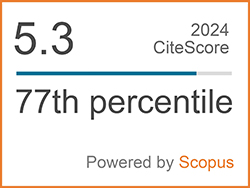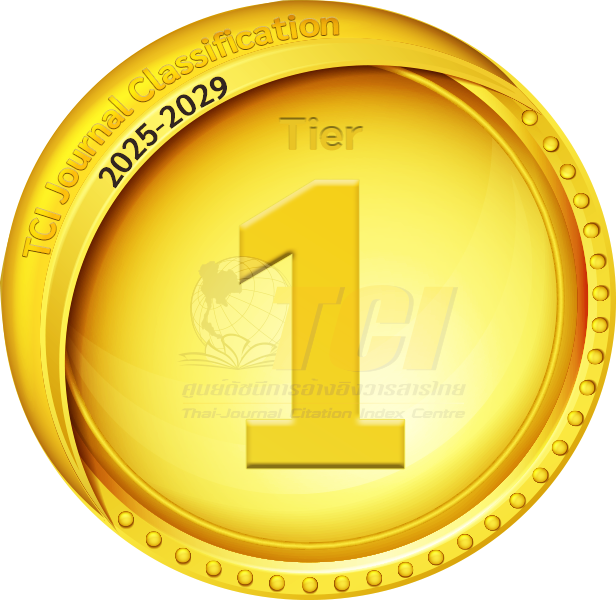Characteristics of Membranes Derived from Pineapple Biowaste: The Effect of Nanoclay Addition
Abstract
Keywords
[1] K. Zaman, M. Malik, U. Awan, W. Handayani, M. K. Jabor, and M. Asif, “Environmental effects of bio-waste recycling on industrial circular economy and eco-sustainability,” Recycling, vol. 7, no. 4, 2022, doi: 10.3390/recycling7040060.
[2] N. Putu and W. Romianingsih, “Waste to energy in Indonesia: Opportunities and challenges,” Journal of Sustainability, Society and Eco-Welfare, vol. 1, no. 1, pp. 60–69, 2023, doi: 10.61511/ jssew.v1i1.
[3] M. Xu, M. Yang, H. Sun, M. Gao, Q. Wang, and C. Wu, “Bioconversion of biowaste into renewable energy and resources: A sustainable strategy,” Environment Research, vol. 214, p. 113929, 2022, doi: 10.1016/j.envres.2022.113929.
[4] P. Pangsri, T. Wuttipornpun, and W. Songserm, “Mannanase and cellulase enzyme production from the agricultural wastes by the bacillus subtilis P2-5 strain,” Applied Science and Engineering Progress, vol. 14, no. 3, pp. 425–434, Jul. 2021, doi: 10.14416/j.asep.2020.05.002.
[5] M. Siahaan. “Indonesia: Production of pineapple 2024.” statista.com. https://www.statista.com/ statistics/706517/production-of-pineapple-in-indonesia/ (accessed Mar. 18, 2025).
[6] Y. S. K. Dewi and C. J. K. Simamora, “Pineapple (Ananas comosus [L.] Merr.) Cv. queen peel herbal tea with a variety of drying temperatures: bioactive compounds, antioxidant activity and antimicrobial activity,” Food Research, vol. 7, no. 4, pp. 344–351, Aug. 2023, doi: 10.26656/fr.2017.7(4).005.
[7] N. Kongkum, V. Phakeenuya, and S. Kongruang, “Optimization of microcrystalline cellulose production from Brewer’s Spent grain by acid hydrolysis,” Applied Science and Engineering Progress, vol. 18, no. 2, p. 7624, 2025, doi: 10.14416/j.asep.2024.11.002.
[8] U. Yanuhar, H. Suryanto, I. K. Ningrum, and A. Aminnudin, “Effect of titanium dioxide nanoparticle on properties of nanocomposite membrane made of bacterial cellulose,” Journal of Natural Fibers, vol. 19, no. 16, pp. 13914–13927, 2022, doi: 10.1080/15440478.2022.2112797.
[9] A. Pandey, M. K. Singh, and A. Singh, “Bacterial cellulose: A smart biomaterial for biomedical applications,” Journal of Material Research, vol. 39, no. 1, pp. 2–18, 2024, doi: 10.1557/s43578-023-01116-4.
[10] P. Cazón and M. Vázquez, “Bacterial cellulose as a biodegradable food packaging material: A review,” Food Hydrocolloid, vol.113, p. 106530, 2021, doi: 10.1016/j.foodhyd.2020.106530.
[11] T. Mahsuli, A. Larasati, A. Aminnudin, and J. Maulana, “Effect of the homogenization process on titanium oxide-reinforced nanocellulose composite membranes,” Journal of Mechanical Engineering Science and Technology (JMEST), vol. 7, no. 2, pp. 137–146, Nov. 2023, doi: 10.17977/um016v7i22023p137.
[12] N. F. Al Harby, M. El-Batouti, and M. M. Elewa, “Prospects of Polymeric nanocomposite membranes for water purification and scalability and their health and environmental impacts: A review,” Nanomaterials, vol. 12, no. 20, 2022, doi: 10.3390/nano12203637.
[13] M. R. Esfahani, S. A. Aktij, Z. Dabaghian, M. D. Firouzjaei, A. Rahimpour, J. Eke, I. C. Escobar, L. F. Greenlee, A.R. Esfahani, A. Sadmani, and N. Koutahzadeh, “Nanocomposite membranes for water separation and purification: Fabrication, modification, and applications,” Separation Purification Technology, vol. 213, no. December 2018, pp. 465–499, 2019, doi: 10.1016/j.seppur.2018.12.050.
[14] J. H. Jhaveri and Z. V. P. Murthy, “Nanocomposite membranes,” Desalination and Water Treatment, vol. 57, no. 55, pp. 26803–26819, 2016, doi: 10.1080/19443994.2015. 1120687.
[15] A. Awasthi, P. Jadhao, and K. Kumari, “Clay nano-adsorbent: structures, applications and mechanism for water treatment,” SN Applied Science, vol. 1, no. 9, pp. 1–21, 2019, doi: 10.1007/s42452-019-0858-9.
[16] A. Kausar, I. Ahmad, M. Maaza, and M. H. Eisa, “State-of-the-art nanoclay reinforcement in green polymeric nanocomposite: From design to new opportunities,” Minerals, vol. 12, no. 12, pp. 1–23, 2022, doi: 10.3390/min12121495.
[17] I. C. E. Utari, U. Yanuhar, A. M. S. Hertika, H. Suryanto, J. Maulana, N.R. Caesar, M. Ismail, “Characterization and performance nanofiltration membranes in water quality for Goldfish (Carassius auratus) aquaculture,” Journal of Mechanical Engineering Science and Technology (JMEST), vol. 8, no. 2, pp. 332–344, Oct. 2024, doi: 10.17977/um016v8i22024p332.
[18] D. Shelly, V. Singhal, S. Singh, T. Nanda, R. Mehta, S.-Y. Lee, and S.-J. Park, “Exploring the Impact of Nanoclay on epoxy nanocomposites: A comprehensive review,” Journal of Composites Science, vol. 8, no. 12, p. 506, 2024, doi: 10.3390/jcs8120506.
[19] T. Korumilli, A. Abdullahi, T. S. Kumar, and K. J. Rao, “22 - Nanoclay-reinforced bio-composites and their packaging applications,” in Nanoclay-Based Sustainable Materials, V.V.T. Padil, Ed. Amsterdam, Netherlands : Elsevier, pp. 467–485, 2024, doi: 10.1016/B978-0-443-13390-9.00022-9.
[20] M. Muhajir, H. Suryanto, Y. R. A. Pradana, and U. Yanuhar, “Effect of homogenization pressure on bacterial cellulose membrane characteristic made from pineapple peel waste,” Journal of Mechanical Engineering Science and Technology (JMEST), vol. 6, no. 1, pp. 34–39, 2022, doi: 10.17977/um016v6i12022p034.
[21] N. K. Yadav, N. S. Rajput, S. Kulshreshtha, and M. K. Gupta, “Investigation of the mechanical and wear properties of epoxy resin composite (ERCs) made with nano particle TiO2 and cotton fiber reinforcement,” Evergreen, vol. 10, no. 1, pp. 63–77, 2023, doi: 10.5109/6781041.
[22] M. G. Ybañez and D. H. Camacho, “Designing hydrophobic bacterial cellulose film composites assisted by sound waves,” RSC Advanced, vol. 11, no. 52, pp. 32873–32883, 2021, doi: 10.1039/ d1ra02908h.
[23] ICDD Data Base, “Cellulose I beta,” The International Centre for Diffraction Data, Ref. Code. 00-056-1718, 2012.
[24] R. Thandavamoorthy, Y. Devarajan, and S. Thanappan, “Analysis of the characterization of NaOH-treated natural cellulose fibre extracted from banyan aerial roots,” Scientific Report, vol. 13, no. 1, p. 12579, 2023, doi: 10.1038/s41598-023-39229-9.
[25] W. Somphol, N. Chanka, and T. Boonmalert, “Extraction of cellulose nanocrystals and nanofibers from rubber leaves and their impacts on natural rubber properties,” Applied Science and Engineering Progress, vol. 17, no. 2, 2024, Art.no. 7281, doi: 10.14416/j.asep.2023.11.010.
[26] P. Tsekova and O. Stoilova, “Fabrication of electrospun cellulose acetate/nanoclay composites for pollutant removal,” Polymers (Basel), vol. 14, no. 23, p. 5070, 2022, doi: 10.3390/ polym14235070.
[27] G. Madhumitha, J. Fowsiya, S. Mohana Roopan, and V. K. Thakur, “Recent advances in starch–clay nanocomposites,” International Journal of Polymer Analysis and Characterization, vol. 23, no. 4, pp. 331–345, May 2018, doi: 10.1080/ 1023666X.2018.1447260.
[28] N. Merah, F. Ashraf, and M. M. Shaukat, “Mechanical and moisture barrier properties of epoxy–nanoclay and hybrid epoxy–nanoclay glass fibre composites: A review,” Polymers (Basel), vol. 14, no. 8, p. 1640, 2022, doi: 10.3390/polym14081620.
[29] V. A. Agubra, P. S. Owuor, and M. V. Hosur, “Influence of nanoclay dispersion methods on the mechanical behavior of E-glass/epoxy nanocomposites,” Nanomaterials, vol. 3, no. 3, pp. 550–563, 2013, doi: 10.3390/nano3030550.
[30] M. Razavi-Nouri, A. Sabet, M. Tayefi, and M. Imeni, “Effect of organoclay ordering and agglomeration on morphology and mechanical properties of uncured and dynamically cured ethylene-octene copolymer nanocomposites,” Macromolecular Materials and Engineering, vol. 301, no. 12, pp. 1513–1524, Dec. 2016, doi: 10.1002/mame.201600255.
[31] R. Vârban, I. Crișan, D. Vârban, A. Ona, L. Olar, A. Stoie, and R. Ștefan, “Comparative FTIR prospecting for cellulose in stems of some fiber plants: Flax, velvet leaf, hemp and jute,” Applied Sciences, vol. 11, no. 18, Sep. 2021, doi: 10.3390/app11188570.
[32] A. Bayraktar and C. Gürsoy, “Production of new nano-bacterial cellulose with Lactobacillus rhamnosus by using whey waste as substrate with optimization Tguchi method,” Research Square, Jan. 05, 2024. doi: 10.21203/rs.3.rs-3828016/v1.
[33] M. Razavi-Nouri, A. Sabet, M. Tayefi, and M. Imeni, “Differentiating between natural and modified cellulosic fibres using ATR-FTIR spectroscopy,” Heritage, vol. 5, no. 4, pp. 4114–4139, Dec. 2022, doi: 10.3390/heritage5040213.
[34] D. O. Govea-Alonso, M. J. García-Soto, L. Betancourt-Mendiola, E. Padilla-Ortega, S. Rosales-Mendoza, and O. González-Ortega, “Nanoclays: Promising materials for vaccinology,” Vaccines (Basel), vol. 10, no. 9, p. 1549, 2022, doi: 10.3390/vaccines10091549.
[35] F. N. Ajjan, M. J. Jafari, T. Rębiś, T. Ederth, and O. Inganäs, “Spectroelectrochemical investigation of redox states in a polypyrrole/lignin composite electrode material,” Journal of Materials Chemistry A, vol. 3, no. 24, pp. 12927–12937, Jun. 2015, doi: 10.1039/ c5ta00788g.
[36] H. Farrokhi, M. Koosha, N. Nasirizadeh, M. Salari, M. Abdouss, T. Li, and Y. Gong, “The effect of nanoclay type on the mechanical properties and antibacterial activity of Chitosan/PVA nanocomposite films,” Journal of Composites Science, vol. 8, no. 7, Jul. 2024, doi: 10.3390/jcs8070255.
[37] J. J. Encalada-Alayola, Y. Veranes-Pantoja, J. A. Uribe-Calderón, J. V. Cauich-Rodríguez, and J. M. Cervantes-Uc, “Effect of type and concentration of nanoclay on the mechanical and physicochemical properties of bis-GMA/TTEGDMA dental resins,” Polymers (Basel), vol. 12, no. 3, Mar. 2020, doi: 10.3390/ polym12030601.
[38] H. Y. Ünal, G. Öner, and Y. Pekbey, “Comparison of the experimental mechanical properties and DMA measurement of nanoclay hybrid composites,” European Mechanical Science, vol. 2, no. 1, pp. 31–36, Dec. 2017, doi: 10.26701/ems.356823.
[39] Y. Zare and K. Y. Rhee, “Simulation of Young’s modulus for clay-reinforced nanocomposites assuming mechanical percolation, clay-interphase networks and interfacial linkage,” Journal of Materials Research and Technology, vol. 9, no. 6, pp. 12473–12483, Nov. 2020, doi: 10.1016/j.jmrt.2020.08.097.
[40] A. Ahmed, A. A. Mahmoud, and S. Elkatatny, “The combined effect of nanoclay powder and curing time on the properties of class G cement,” Geofluids, vol. 2023, 2023, doi: 10.1155/2023/ 7316335.
[41] T. R. Sobahi, M. Y. Abdelaal, and M. A. Salam, “Structure and physical properties of cellulose triacetate/nanoclay nanocomposites,” Indian Journal of Chemical Technology, vol. 27, pp. 85–89, 2020.
[42] M. H. Gabr, N. T. Phong, M. A. Abdelkareem, K. Okubo, K. Uzawa, I. Kimpara, and T. Fujii, “Mechanical, thermal, and moisture absorption properties of nano-clay reinforced nano-cellulose biocomposites,” Cellulose, vol. 20, no. 2, pp. 819–826, 2013, doi: 10.1007/s10570-013-9876-8.
[43] S. S. Chee, M. Jawaid, O. Y. Alothman, and H. Fouad, “Effects of nanoclay on mechanical and dynamic mechanical properties of bamboo/kenaf reinforced epoxy hybrid composites,” Polymers (Basel), vol. 13, no. 3, 2021, doi: 10.3390/ polym13030395.
[44] S. I. Hossain, E. A. Kukushkina, M. Izzi, M. C. Sportelli, R. A. Picca, N. Ditaranto, and N. Cioffi, “A Review on Montmorillonite-Based Nanoantimicrobials: State of the Art,” Nanomaterials, vol. 13, no. 5, p. 848, 2023, doi: 10.3390/nano13050848.
[45] M. Z. M. Vazifeh, S. M. Hosseini, M. H. Seyed, A. Mohammadi, and H. Maleki, “Investigation of the antimicrobial properties of nanoclay and chitosan based nanocomposite on the microbial characteristics of Gouda cheese,” Iranian Journal of Microbiology, vol. 12, no. 2, pp. 121–126, 2020.
[46] A. H. Mohsen, N. A. Ali, S. I. Hussein, A. Y. A. Mohammed, A. M. Alraih, and A. M. Abd-Elnaiem, “Investigation of optical, mechanical, thermal, wettability, and antibacterial activity of polyvinyl alcohol mixed with clay nanoparticles,” Inorganic Chemistry Communication, vol. 167, 2024, Art. no. 112841, doi: 10.1016/j.inoche. 2024.112841.
[47] M. Lee, D. Kim, J. Kim, J. K. Oh, H. Castaneda, and J. H. Kim, “Antimicrobial Activities of Thermoplastic polyurethane/clay nano-composites against pathogenic bacteria,” ACS Applied Bio Materials, vol. 3, no. 10, pp. 6672–6679, Oct. 2020, doi: 10.1021/acsabm.0c00452.
[48] J. Ren, H. Weng, B. Li, F. Chen, J. Liu, and Z. Song, “The influence mechanism of pore structure of tectonically deformed coal on the adsorption and desorption hysteresis,” Frontier Earth Science, vol. 10, 2022, doi: 10.3389/ feart.2022.841353.
[49] I. A. Borojeni, A. Jenab, M. Sanjari, and C. Boudreault, “Effect of nanoclay addition on the morphology, fiber size distribution and pore size of electrospun polyvinylpyrrolidone (PVP) composite fibers for air filter applications,” Fibers, vol. 9, no. 8, 2021, doi: 10.3390/ fib9080048.DOI: 10.14416/j.asep.2025.06.002
Refbacks
- There are currently no refbacks.
 Applied Science and Engineering Progress
Applied Science and Engineering Progress







